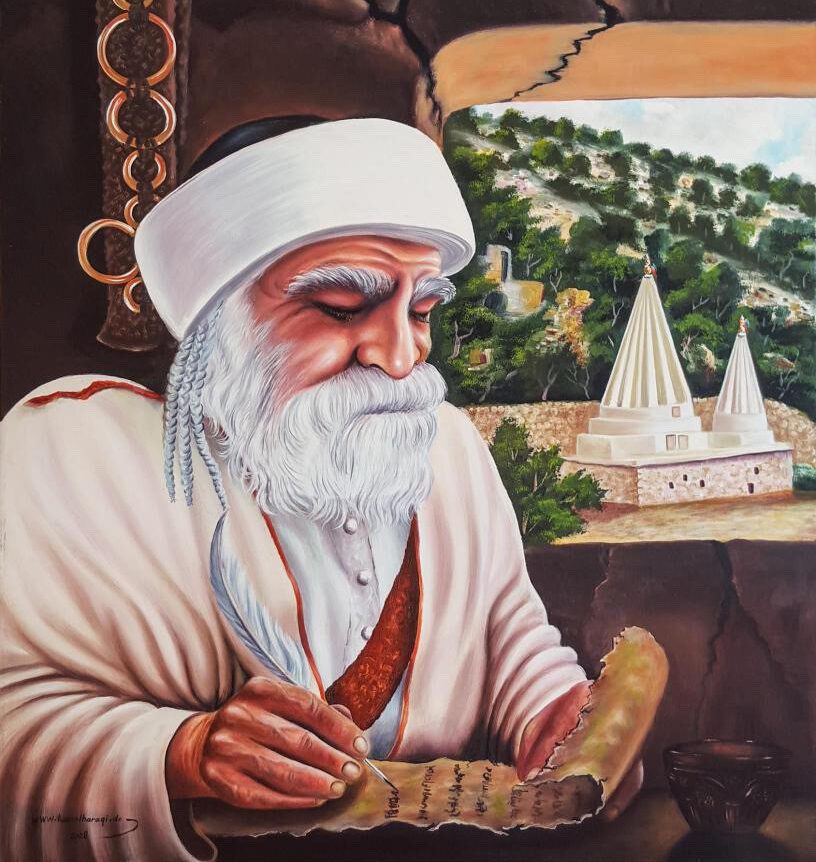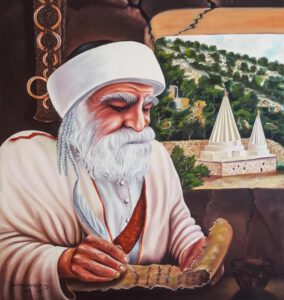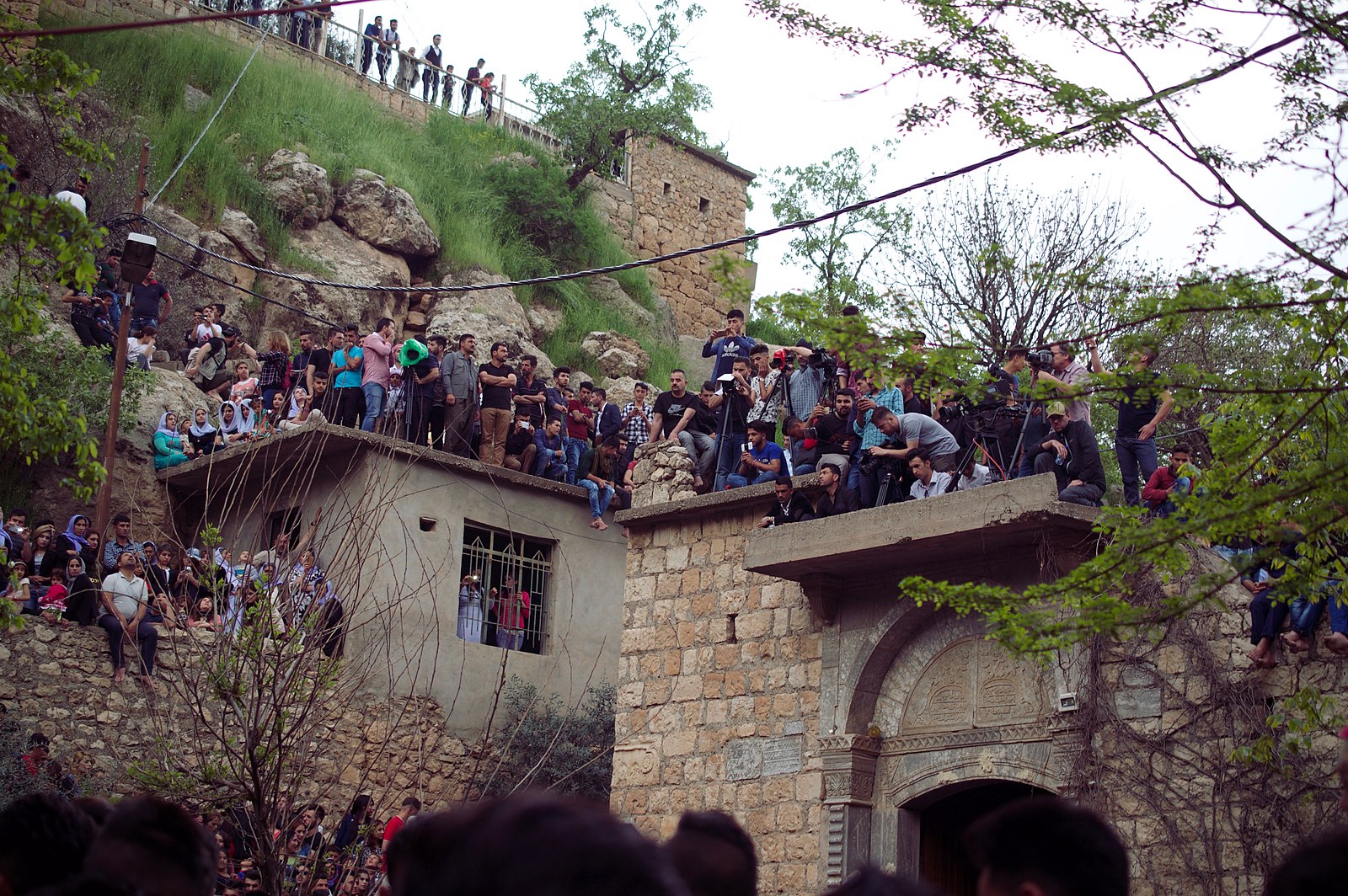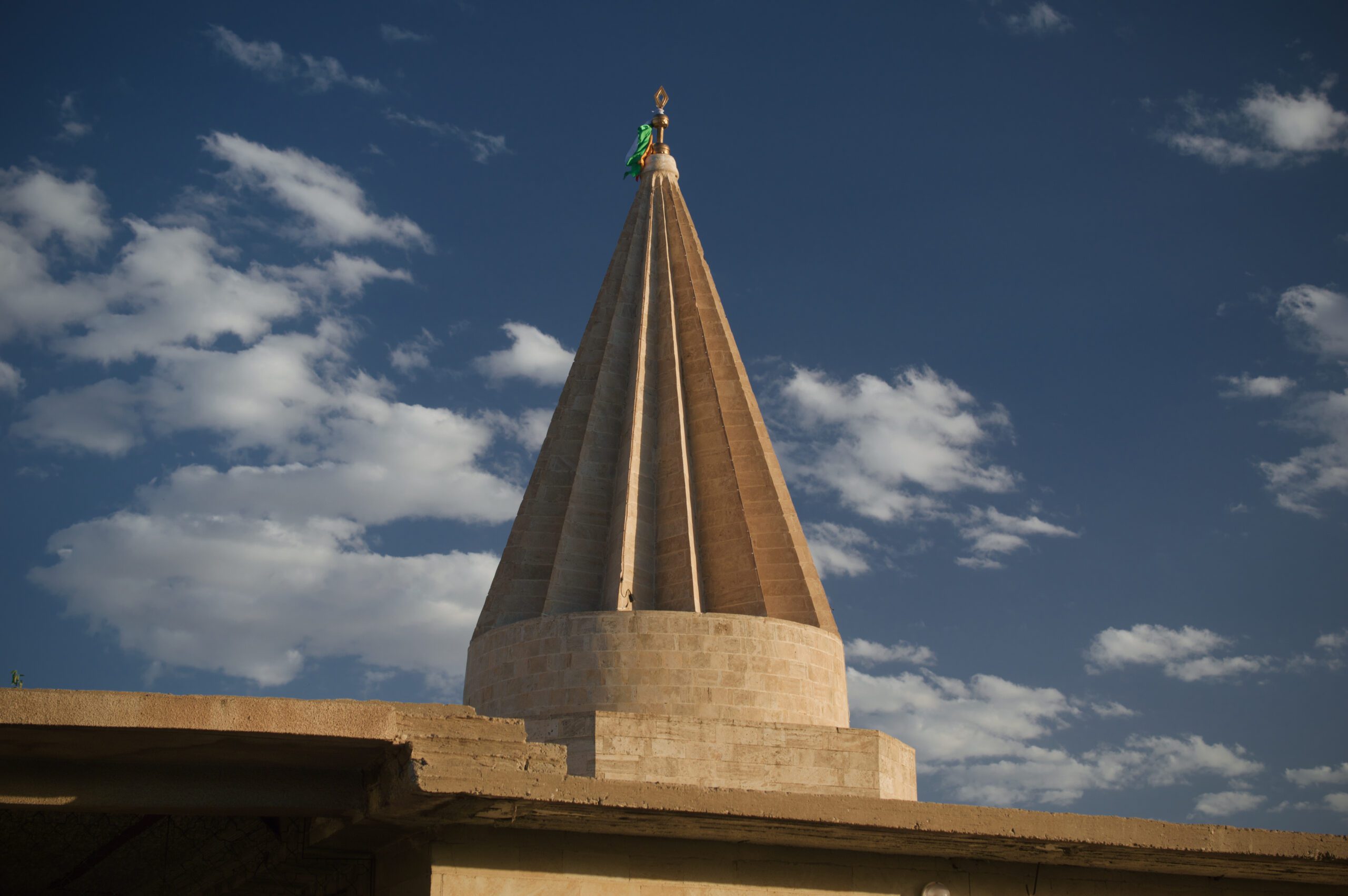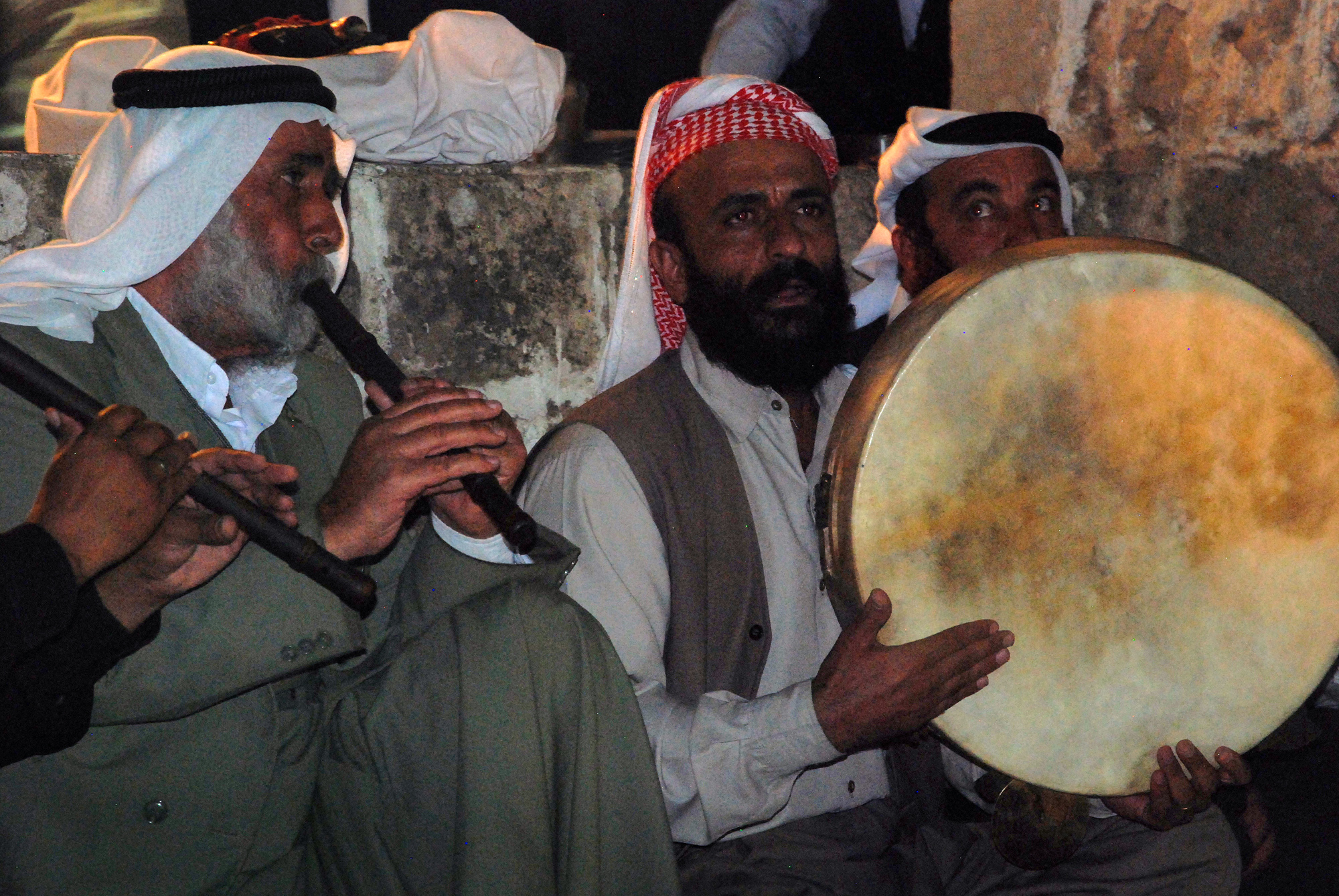Şemsanî
Şemsanî, also occasionally known as Zerzanî, are one of the three principal endogamous and hereditary clans that constitute the Şêx caste, alongside the Adanî and the Qatanî. The Şêxs are one of the two priestly castes alongside the Pîrs, and they are responsible for carrying out administrative and religious tasks within the Ezidi community.[1]Dîma, Pîr. Êzdîyên Serhedê: Sedsala XIX – Destpêka XX. Translated by Ezîzê Cewo, Weşanxaneya Do, 2011. pp. 36-37[2]Omerxalî, Xanna and Xankî, Kovan. Metodeke Analîza Qewlên Êzdiyan: Li Ser Mesela Qewlê Omer Xala Û Hesen Çinêrî. Avesta Basın Yayın, 2009. p. 43
Ancestry
The Şemsanî Şêxs descend from Êzdîna Mîr and his four sons. His two eldest sons being Şêx Şems (Şemsedîn) and Şêx Fexir (Fexredîn) born to his first wife Sitîya Zîn, who is the daughter of Şîxadî II (Şêx Adî ibn Sexr Ebû’l Berekat) and sister of Şêxisin (Şêx Hesen),[3]Xêrî Bozanî, Şêx Fexirê Adiyan: Jiyan û Berhem, in: Şêx Fexrê Adiyan: Fîlosof û xasê ola Êzdiyatiyê, ed. E. Boyîk et al., Oldenburg 2009, pp. 180–203. a relation also substantiated by the first stanza from Qesîda Şêşims û Şêx Fexir:[4]Şemo Qasim Dinanî, Çend Têkistên Pîroz yên Ola Êzdiyan, vol. 2, Duhok, 2012. pp. 276-277
1. Şemsedîne û Fexredîn,
Şemsedîn and Fexredîn,
2. Herdû pisêt Sitîya Zîn,
Both are the sons of Sitîya Zîn,
3. Herdû xelefêt Şêx Êzdîn,
Both are offspring of Şêx Êzdîn,
4. Herdû neviyêt Şerfedîn.
Both are grandchildren of Şerfedîn.
Şerfedîn is considered the real and first name of Şîxadî, as found in his full name recorded in historical records.[5]Pîr Dîma, Şîxadî û Êzdîtî, in the book: Şîxadî, ed. Eskerê Boyîk, Oldenburg 2016, pp. 26-38. Thus, the Şerfedîn mentioned here likely refers to Şîxadî II, who is considered indistinguishable from the first Şîxadî in Ezidi tradition, as they are believed to share the same essence (‘surr’).[6]Mîrza Şêx Silêman, Şîxadî Li Gor Têkistên Dînê Êzîdiyan, in the book: Şîxadî, ed. Eskerê Boyîk, Oldenburg 2016, pp. 81-101. The other two sons of Êzdîna Mîr, Sicadîn and Nasirdîn were born to his second wife Sitîya Ereb, who was the sister of Şêx Hentûş.[7]Xêrî Bozanî, pp. 180-203 These four sons are the progenitors of the four principal Şemsanî lineages which are named after them. According to Ezidi tradition, their ancestral home was Mikêris, which is an abandoned village in the now-islamized Etrûş area of the north of the Laliş sanctuary in Şêxan district.[8]Khatari, Dawd Murad “من اثار الايزيدية. . .الحلقة الاولىالباحث . داود مراد ختاري” [Video]. Ezidi Researcher Dawd Murad Khatari visits Mkeris village. … Continue reading[9]Şêx Fexrê Adiyan: Fîlosof û xasê ola Êzdiyatiyê, ed. E. Boyîk et al., Oldenburg 2009, pp. 187, 230, 288 The dates of their lifetimes have not been definitively established and remain a topic of debate. However, there is a general consensus among scholars that this family lived between the second half of the 12th century and the end of 13th century. We have more precise records about the lifespan of Şêx Hesen (Melik Şêxisin), uncle of Şêx Şems and Şêx Fexir who is reported to have lived between 1195-1246 AD. Extrapolating from there, we can estimate that the Şemsanî progenitors lived during 13th century[10]Ibid. pp. 10, 87, 231[11] John S Guest. The Yezidis: A Study in Survival. KPI Ltd, 1987. pp. 19-20
There is a dispute regarding Êzdîna Mîr’s ancestry. According to Ezidi tradition, his mother’s name was Sitîya Hezret,[12]Rodziewicz, Artur. Eros and the Pearl: The Yezidi Cosmogonic Myth at the Crossroads of Mystical Traditions. Peter Lang GmbH, Internationaler Verlag Der Wissenschaften, 2022. p. 613[13]Also recorded in C. J. Edmonds’ book “A Pilgrimage to Lalish”, which is based on his travels between 1930-1945, p. 31 while his father’s name is disputed, with some accounts naming him as Îsmaîl or Melik Salim.[14]In interviews conducted by the present author with other Şemsanî Şêxs, both names were mentioned.[15]Xêrî Bozanî, pp. 180-203 Some researchers have speculated that Êzdîna Mîr might be a descendant of Şîxadî’s nephew, Sexr Ebû’l Berekat, with one speculation even suggesting that Êzdîna Mîr might be a pseudonym for Melik Şêxisin (Şêx Hesen).[16]Artur Rodziewicz, pp. 617-620 However, these are unsubstantiated speculations. They are highly unlikely to be true, as genealogical data from the Iraqi DNA Project, based on genetic samples collected from some Adanî Şêxs (direct descendants of Şêx Hesen) and Şemsanî Şêxs, has shown that they belong to two different lines of patrilineal descent.[17]Samples collected from Ezidis by the Iraqi DNA Project revealed that the Şêxs of the Şemsanî and Adanî clans belonged to different Y-DNA haplogroups: the Şemsanîs to R1b-Z2103 and the Adanîs … Continue reading There is also an opinion among some Ezidis that Şemsanîs belong to a family who inhabited and ruled the Laliş area prior to the coming of Şîxadî,[18]Xêrî Bozanî, pp. 180-203[19]Feqîr Hecı̂, Bedelê. Bawerı̂ Û Mı̂tologı̂ya Êzidı̂yan: Çendeha Têkist û Vekolı̂n. Hawar, 2002. p. 302 although to date, there’s no historical data to substantiate this.
Lineages
As mentioned earlier, Şemsanîs are divided into four primary lineages from Êzdîna Mîr’s four sons, Şêx Şems, Şêx Fexir, Nasirdîn and Sicadîn, with the former two being divided into further sublineages descending from their offspring.
Binemala Şêx Şems (House of Şêx Şems)
Şêx Şems had nine sons: Şêx Xidir, Şêx Babik, Şêx Tokil, Mîr Amadîn, Babadîn, Şêx Havind, Şêx Al, Şêx Hesen and Şêx Evdalê Bisk, as well as three daughters: Sitîya Bilxan (Bilqan), Sitîya Îs (Ês) and Sitîya Nisret.[20]Pirbari, Dimitri. Lalişa Nûranî, Ekaterinburg 2018, p. 14 From his household, the following lineages can be found:
1. Şêx Şems lineage (Şêxên Şêşimsa): Descended from Şêx Xidir, one of the sons of Şêx Şems, who is the earthly incarnation of one of the Seven Angels, namely Melek Şemsedîn, considered the Xudan (patron, protector, lord, master) of the Sun and protector of Ezidis. Şêxs of this lineage are in charge of the Şêxê Wezîr title.[21]”Shams or Sheshems – is this God?” – Answers to questions about Ezidism, official website of the Spiritual Council of Ezidis in Georgia (Atqat.com) Retrieved July 18, 2024, from … Continue reading[22]Silêman, Pîr Xidir. Êzidyatî: Wane Bo Qutabîyêt Êzidya Ji Pola (1-6) Qunaxa Seretayî. 1996. p. 17[23]Pîr Dîma, 2011, p. 46
1.1. Şêx Cin Teyar lineage (Şêxên Cin Teyar), also known as Şêxê Reş: Cin Teyar translates to “The Flying Jinn.” Although not named after one of Şêx Şems’ sons, their lineage can still be traced back to Şêx Şems. In Ezidi mythology, “Cin,” also referred to as “ji me çêtir” (‘those who are better than us’), refers to invisible spirits that are neither inherently evil nor good and are believed to live under the reign of Şêx Şems. The Şêxs of Cin Teyar live in Turkey, Armenia, and Georgia and are not allowed to intermarry with other Şemsanîs. They possess the special ability to heal people suffering from mental afflictions and illnesses. In the 19th century, the Kurdish-Muslim cleric Mela Mehmûd Beyazîdî mentioned “Şêxên Cindar” among the Kurds, who also had the power to cure mental illnesses, without describing them as Ezidis. Additionally, among the Muslim Kurds of Erzurum, there exist “Şêxên Reş”. It is likely that these are a section of Şêxên Cin Teyar who became islamized and remained in Serhed, while those who remained loyal to their faith migrated to the Caucasus with other Ezidi tribes.[24]Ibid. pp. 50-51
1.2. Şêxê Dara Miraza lineage (Şêxên Dara Miraza): Literally “Sheikhs of the Wishing Tree lineage”, this lineage can be traced to Şêx Xidirê Şemsa, and thus back to the Şêx Şems lineage, likely splitting off and becoming a separate lineage at a later period. They can only be found among Ezidis of Caucasus. People go and visit their households to ask and pray for their wishes to be granted.[25]Ibid. pp. 50-51
1.3. Şêxê Toxa Enzel lineage (Şêxên Toxa Enzel): This lineage can also be traced back to the lineage of Şêx Şems, likely splitting off and becoming a separate lineage at a later period. They are found only among the Ezidis of Caucasus.[26]Ibid. pp. 49-50
2. Mîr Amadîn ê Şemsa lineage (Şêxên Amadîna): Descended from Mîr Amadînê Şemsa, a saint associated with curing stomach ache, a curative power which his descendants still possess today. Furthermore, they are forbidden to eat roosters, the totem animal of Amadîn. According to Ezidi tradition, Mîr Amadîn was the ruler of the city of Amadiya (Amêdî), today situated in Duhok Governorate in the Kurdistan Region of Iraq. Amadiya was the historical capital of Badînan/Behdînan principality, which was founded by Mîr Amadîn.[27]Ibid. p. 48[28]Hesen, Rêsan. “Şêx Hesen û Hizra Pêkînana Dewleteke Kurdî.” Govara Mehfel 1, Summer 2010, pp. 1–7[29](Xidir Pîr Silêman) خدر بير سليمان. “(Darkêt Mîr Amadîn) داركيت مير ئامادين.” (Lalish Media Network) شبكة لالش الاعلامية, 18 June 2016, … Continue reading This is also substantiated in the book Şerefname, where it is reported that the Bahdinan rulers descend from a certain Behdîn (Baha ad-Din), whose brothers were Şêx Mend, an Ezidi saint who founded the Aleppo/Kilis principality and was also a member of the Şemsanî family, and a certain Şemsedîn, who founded the Hakkari principality.[30]Bedlîsî, Şerefxanê. Şerefname: Dîroka Kurdistanê. Azad Yayınevi, 2014. p. 267 Although this genealogy does not fully match with Ezidi tradition, it suggests that they were likely relatives of the same family and that the founding members of those principalities were Ezidis, in which case, this Behdîn would likely have been an offspring of Mîr Amadîn. In a stanza from a variant of Beyta Şerfedîn, there is also a possible mention of Badînan in reference to Amadîn:[31]Derwêş Casim, Îvan. “Sirûda Şerfedîn bi zimanê Mûzîkî” Govara Laliş 13, August 2000, pp. 222-223
1. Hol badîne ber bendê da,
Hol badîne[32]A phrase that appears in many Ezidi recitations. The exact meaning is not clear. at the service,
2. Naçime şerê Badîn têda,
I shall not go at war in Badîn,
3. Amadîne wêt pêşiyê da.
Amadîn is at the front.
To provide additional evidence of historical Ezidi presence in the Amadiya region, the tax register of Pîr Xetî Pisî’s Mişûr, a type of manuscript produced in the 13th century, lists “Rūbār ‘Amādiyya” (‘River of Amadiya’) as one of the regions subject to religious taxation (‘fitû’) as Mirîds of Pîr Xetî Pisî.[33]Omarkhali, Khanna. The Yezidi Religious Textual Tradition, from Oral to Written: Categories, Transmission, Scripturalisation, and Canonisation of the Yezidi Oral Religious Texts: With Samples of Oral … Continue reading
Şêxs of Amadîn lineage are in the charge of the spiritual title of “Babê Gavan”, who has the task of instructing Ezidis and overseeing some religious rituals.[34]Дмитрий Пирбари. “Религиозные Должности в Системе Духовной Иерархии Езидов.” Новый Взгляд (Nêrîna Nû), No. 2, Sept. … Continue reading
3. Şêx Alê Şemsa lineage (Şêxên Şêx Alê Şemsa): A rare lineage residing only in Georgia today, descending from Şêx Alê Şemsa, who also sometimes appears in Ezidi stories through the name Miskîn Tajdîn. There is a story (‘serhatî’) about him going on a journey towards Syria and being imprisoned in the city of Aleppo for seven years.[35]Pîr Dîma, 2011, p. 49
4. Şêx Evdalî Bisk / Evdalê Gulî (Şêxên Şêx Evdalî Bisk): Xudan of scissors (‘meqes’) and earlocks (‘bisk’), both symbols of an Ezidi rite of passage referred to as “Biskhildan”, in which a Şêx cuts a lock of hair from his Mirîd’s newborn.[36]Ibid[37]Pîr Êzdîn. Qewl, Beyt, Qesîda, Dû’a yên Êzdiyan, p. 323
5. Şêx Hesenê Celê: Although Şêx Hesen’s descendants still live today, their lineage is named after his wife Xatûna Fexra (‘Şêxên Xatûna Fexra’), the daughter of Şêx Fexir. According to Ezidi tradition, Şêx Hesen was banished from his home after committing a huge sin, which got him the name Şêx Hesenê Celê, translating to “Şêx Hesen the Banished”. This resulted in his lineage being named after his wife Xatûna Fexra instead.[38]Pîr Dîma, 2011, p. 48[39]Interviews conducted with representatives of Xatûna Fexra lineage by the present author
6. Şêx Babik ê Şemsa lineage (Şêxên Şêx Babikê Şemsa)[40]Pîr Dîma, 2011, pp. 48-49
7. Babadîn ê Şemsa lineage (Şêxên Babadîna)[41]A rare lineage not well-documented in sources, the Şêxs of the Babadîn lineage were confirmed to exist through interviews conducted by the present author with some representatives of the Şemsanî … Continue reading[42]سیدو ختو حسو (٢٠٢١) شرۆڤەکرنا هندەک رێ ورەسم وتێکستێن ئۆلا ئێزدیان (Sîdo Xeto Heso, 2021, Şirovekirina Hindek Rê û Resm û Têkistên Ola … Continue reading
8. Şêx Tokil ê Şemsa (Şêxên Tokila)[43]Ibid
9. Şêx Havind ê Şemsa (Şêxên Şêx Havinda)[44]Ibid
Binemala Şêx Fexir (House of Şêx Fexir)
1. Şêx Fexir / Fexredîn lineage (Şêxên Fexra): Descended from Şêx Fexredîn, a 13th-century Ezidi saint, philosopher, and cleric who composed 11,000 Ezidi hymns and is considered the earthly incarnation of one of the Seven Angels, specifically Melek Fexredîn, the Xudan of the Moon. Some families of this lineage hold the spiritual leadership title of Baba Şêx / Extiyarê Mergehê and descend from Aqûbê Mûsa, Fexredîn’s first successor to the title of Extiyarê Mergehê.[45]Pîr Dîma, 2011, p. 46[46]Xêrî Bozanî, pp. 180-203[47]Mossaki, N. Z., & Pirbari, D. V. (2021). THE DEATH OF BABA SHEIKH AND THE SPLIT OF THE YEZIDI COMMUNITY. Vestnik Instituta Vostokovedeniâ RAN, 2 (16), 129–143. … Continue reading According to some clerics, Aqûbê Mûsa was adopted by Şêx Fexir as his son,[48]Ibid while others believe he was his son from another wife.[49]Feqîr Hecı̂, Bedelê. Laliş Name: Lêkolîn – Têkist – Gotar, 2019. p. 29 It is unclear if this lineage also includes descendants of Şêx Bedir, a son of Fexredîn who lacks a lineage named after him.
2. Şêx Mend lineage (Şêxên Şêx Menda): Descended from Fexredîn’s eldest son Şêx Mend Paşayê Helebê, who is a famous saint that is known as the Xudan of Snakes and was the founder of a principality that ruled regions of Aleppo and Kilis, also corroborated in the Şerefname, which reports that he was appointed as the Lord of all Kurds in Aleppo, Kilis and Damascus. His descendants have the special power to tame snakes and cure snake bites. For more about him, see here.
3. Xatûna Fexra lineage (Şêxên Xatûna Fexra): Descended from the daughter of Şêx Fexir, Xatûna Fexra (real name: Xezal[50]Xêrî Bozanî, pp. 180-203), and her husband Şêx Hesenê Celê, a son of Şêx Şems. As mentioned earlier, due to Şêx Hesen’s banishment, this lineage was named after Xatûna Fexra. Xatûna Fexra is a well-known saint in Ezidism, known as the Xudan of pregnancy and birth, as well as the protector of women and children.[51]Pîr Dîma, 2011, p. 48
Nasirdîn & Sicadîn
Although Nasirdîn and Sicadîn, brothers from the same mother, have their own Şêx lineages named after them, unlike Şêx Fexir and Şêx Şems’ houses, they are not divided into further sublineages named after their offspring. Rather, their descendants are simply known as “Şêxên Nasirdîna” and “Şêxên Sicadîna,” respectively. In Ezidism, Nasirdîn and Sicadîn are considered the earthly incarnations of two of the Seven Angels: Melek Nasirdîn, the Angel of Death and Renewal who separates the soul from the body upon a person’s death, and Melek Sicadîn, the Messenger of Death. Both will come to a person during their death and ask the soul to recite the declaration of their faith.[52]Ibid. pp. 46-47[53]Omarkhali, Khanna. (2011). YEZIDI RELIGIOUS ORAL POETIC LITERATURE: STATUS, FORMAL CHARACTERISTICS, AND GENRE ANALYSIS: With some examples of Yezidi religious texts. Scrinium, 7–8(2), 144–195. … Continue reading
Name
The clan is most commonly known by the name Şemsanî, a name that many scholars have linked to various sun-worshipping sects of Mesopotamia, including the Şemsî, who were active in the Mêrdîn and Urfa regions until the late 19th and early 20th centuries.[54]Artur Rodziewicz, pp. 589-623[55]Turgut, Lokman. (2014). Ancient rites and old religions in Kurdistan. https://www.academia.edu/5288926/Ancient_Rites_and_Old_Religions_in_Kurdistan However, this connection cannot be confirmed through historical data or Ezidi tradition. The name is more likely derived from the name of Şêx Şems, who succeeded his father Êzdina Mîr as the family patriarch,[56]Cindî, Xelîl and Silêman, Xidir. Êzdiyatî Liber Roşnaya Hindek Têkistê Ayinê Êzdiyan, 1979. pp. 127-128similar to how the name of the Adanî clan was derived from Adî (Şêx Adî, Şîxadî) and the Qatanî clan from their paternal ancestor Derwêş Qatan.
Another lesser-known name applied to the Şemsanî clan is “Zerzanî”, which tends to be used predominantly among Ezidis of Caucasus.[57]Omerxalî, Xanna and Xankî, Kovan, p. 43[58]Garnik Asatrian, a writer from Armenia, also makes a conflation between the term Şemsanî and Zerzanî in a footnote of the following paper: The Holy Brotherhood (1999) Although the origin or meaning of this name is unclear, “Zerzanî”, also appearing under the form of “Zerzayî” or “Zerza” appears frequently in Ezidism. It is applied as a name to some saints that do not necessarily belong to the Şemsanî clan or even the Şêx caste, such notable saints include Babekirê Omerayê Zerzayî, who is known to have composed many hymns, and Pîr Gavanê Zerza, patron saint of cattle.[59]Khanna Omarkhali, 2017, p. 91 Despite the connection between the Şemsanîs and the term Zerza not being as well-established among Ezidis in Iraq, it can still be found through the name of a Sema’ dance that is known as “Semaya Zerzaya“. This dance is said to be in the name of Şêx Şems (Şêşims), given as a gift to the Zerzayî, who are in turn said to be the same as Şemsanîs.[60]Pîr Xelat Elyas Ce’fo, and Zuhêr Ereb Silo. Semaya Dînî Di Êzidiyatîyê da. 2015. p. 30
A Muslim Kurdish tribe by this name can also be found today in Turkey, inhabiting areas of the Şemdinli (Şemzînan) district within Hakkari province and Muş province. In Iran, they live near the Iraqi border west of the city of Oshnavieh in West Azerbaijan province.[61]Andrews, Peter Alford, and Rüdiger Benninghaus. Ethnic Groups in the Republic of Turkey. Reichert, 2002. pp. 216-217[62]Oberling, Pierre. (2004, July 20). Kurdish Tribes. Encyclopaedia Iranica. Retrieved July 17, 2024, from https://www.iranicaonline.org/articles/kurdish-tribes Additionally, they are mentioned in the Şerefname as being involved in an old feud with the Soran emirate, which invaded the Zerza territory, killing 350 of their elders and chiefs, taking their women and children as captives and bringing them back to Soran. As it is forbidden for Muslims to capture women and children of their fellow Muslims as a war booty, this points to a high likelihood that these Zerzayî were non-Muslims at the time of the event. Şerefname also mentions a Zerzayî vilayet by the name of Larcan being captured by the Baban principality.[63]Bedlîsî, Şerefxanê, pp. 324, 327
There is also a possible connection with the powerful medieval Kurdish tribe of Zerzarî (Zarzāriyya). According to one source, the Zerzarî also owned fiefs called Malazgird and Rustak,[64]Al-Umari, Ibn Fadlallah, Masālik al-Abṣār fī Mamālik al-Amṣār, Abu Dhabi Cultural Complex, First Edition, 2003. p. 267 which the scholar Minorsky places at south of the Şemdinli (Şemzînan) district in Hakkari province, Turkey.[65]Minorsky, V., Mackenzie, D. N., & Bois, T. KURDS, KURDISTAN. In Encyclopaedia of Islam, Second Edition. https://doi.org/10.1163/1573-3912_islam_com_0544 Zerzarî of Şingal are also mentioned, with one source mentioning an emir in Sinjar (Şingal) who was from Zarzariyya tribe.[66]Richards, D. S. (2010). The Chronicle of Ibn al-Athir for the Crusading Period from al-Kamil fi’l-Ta’rikh. Part 3. Ashgate Publishing, Ltd. p. 287[67]Boris, James (2019). Constructing the Realm of the Kurds (Al-Mamlaka Al-Akradiyya): Kurdish In-betweenness and Mamluk Ethnic Engineering (1130-1340 CE). In Grounded Identities (pp. 17–45). … Continue reading There is evidence that some members of this medieval tribe adhered to the Ezidi faith, with Badr al-Din al-Ayni (b. 1360 AD, d. 1453 AD) mentioning in his book a certain “Sheikh Yaqub bin Muhammad bin Hassan al-Zarzari al-Kurdi al-Adawi” who passed away in 1300 AD.[68]al-Ayni, Badr al-Din, Uqd al-Jumān fī Tārīkh Ahl al-Zamān, Dar al-Kutub wa al-Adathiq al-Qawmiyyah Press – Cairo, 2010. p. 147 The last name “al-Adawi” is a strong indication of belonging to the Ezidi faith and was the name by which many medieval Ezidi figures were referred to. Ezidis rarely use the term “Edewî” today, however, it still found as a synonym to “Ezidi” in Ezidi texts.[69]Pirbari, Dimitri, & Mossaki, Nodar, (2022). A Yezidi Manuscript – Mišūr of P’īr ‘Omar Khālān, its Syudy and Critical Analysis. The Near East and Georgia, No. 14, … Continue reading Although a connection is possible, the specific nature of the relation between the Zarzariyya, today’s Muslim Kurdish tribe of Zerzan and the Şemsanî Şêxs still remains unclear and requires further study.
References[+]
| ↑1 | Dîma, Pîr. Êzdîyên Serhedê: Sedsala XIX – Destpêka XX. Translated by Ezîzê Cewo, Weşanxaneya Do, 2011. pp. 36-37 |
|---|---|
| ↑2 | Omerxalî, Xanna and Xankî, Kovan. Metodeke Analîza Qewlên Êzdiyan: Li Ser Mesela Qewlê Omer Xala Û Hesen Çinêrî. Avesta Basın Yayın, 2009. p. 43 |
| ↑3 | Xêrî Bozanî, Şêx Fexirê Adiyan: Jiyan û Berhem, in: Şêx Fexrê Adiyan: Fîlosof û xasê ola Êzdiyatiyê, ed. E. Boyîk et al., Oldenburg 2009, pp. 180–203. |
| ↑4 | Şemo Qasim Dinanî, Çend Têkistên Pîroz yên Ola Êzdiyan, vol. 2, Duhok, 2012. pp. 276-277 |
| ↑5 | Pîr Dîma, Şîxadî û Êzdîtî, in the book: Şîxadî, ed. Eskerê Boyîk, Oldenburg 2016, pp. 26-38. |
| ↑6 | Mîrza Şêx Silêman, Şîxadî Li Gor Têkistên Dînê Êzîdiyan, in the book: Şîxadî, ed. Eskerê Boyîk, Oldenburg 2016, pp. 81-101. |
| ↑7 | Xêrî Bozanî, pp. 180-203 |
| ↑8 | Khatari, Dawd Murad “من اثار الايزيدية. . .الحلقة الاولىالباحث . داود مراد ختاري” [Video]. Ezidi Researcher Dawd Murad Khatari visits Mkeris village. Retrieved January 15, 2018, from (https://youtu.be/X43UZkmJhe4). Higher quality version of the video is also available on his official Facebook page (https://fb.watch/jNiKkPvm52/) |
| ↑9 | Şêx Fexrê Adiyan: Fîlosof û xasê ola Êzdiyatiyê, ed. E. Boyîk et al., Oldenburg 2009, pp. 187, 230, 288 |
| ↑10 | Ibid. pp. 10, 87, 231 |
| ↑11 | John S Guest. The Yezidis: A Study in Survival. KPI Ltd, 1987. pp. 19-20 |
| ↑12 | Rodziewicz, Artur. Eros and the Pearl: The Yezidi Cosmogonic Myth at the Crossroads of Mystical Traditions. Peter Lang GmbH, Internationaler Verlag Der Wissenschaften, 2022. p. 613 |
| ↑13 | Also recorded in C. J. Edmonds’ book “A Pilgrimage to Lalish”, which is based on his travels between 1930-1945, p. 31 |
| ↑14 | In interviews conducted by the present author with other Şemsanî Şêxs, both names were mentioned. |
| ↑15 | Xêrî Bozanî, pp. 180-203 |
| ↑16 | Artur Rodziewicz, pp. 617-620 |
| ↑17 | Samples collected from Ezidis by the Iraqi DNA Project revealed that the Şêxs of the Şemsanî and Adanî clans belonged to different Y-DNA haplogroups: the Şemsanîs to R1b-Z2103 and the Adanîs to R1a-Z94, proving that they descend from two different direct patrilineal ancestors. (https://www.facebook.com/100068942912887/posts/1048725485321273/) [Retrieved July 14, 2024] |
| ↑18 | Xêrî Bozanî, pp. 180-203 |
| ↑19 | Feqîr Hecı̂, Bedelê. Bawerı̂ Û Mı̂tologı̂ya Êzidı̂yan: Çendeha Têkist û Vekolı̂n. Hawar, 2002. p. 302 |
| ↑20 | Pirbari, Dimitri. Lalişa Nûranî, Ekaterinburg 2018, p. 14 |
| ↑21 | ”Shams or Sheshems – is this God?” – Answers to questions about Ezidism, official website of the Spiritual Council of Ezidis in Georgia (Atqat.com) Retrieved July 18, 2024, from http://atqat.com/faq/0-0-16 |
| ↑22 | Silêman, Pîr Xidir. Êzidyatî: Wane Bo Qutabîyêt Êzidya Ji Pola (1-6) Qunaxa Seretayî. 1996. p. 17 |
| ↑23 | Pîr Dîma, 2011, p. 46 |
| ↑24 | Ibid. pp. 50-51 |
| ↑25 | Ibid. pp. 50-51 |
| ↑26 | Ibid. pp. 49-50 |
| ↑27 | Ibid. p. 48 |
| ↑28 | Hesen, Rêsan. “Şêx Hesen û Hizra Pêkînana Dewleteke Kurdî.” Govara Mehfel 1, Summer 2010, pp. 1–7 |
| ↑29 | (Xidir Pîr Silêman) خدر بير سليمان. “(Darkêt Mîr Amadîn) داركيت مير ئامادين.” (Lalish Media Network) شبكة لالش الاعلامية, 18 June 2016, www.lalishduhok.com/articles/post/100661/. Accessed 16 July 2024 |
| ↑30 | Bedlîsî, Şerefxanê. Şerefname: Dîroka Kurdistanê. Azad Yayınevi, 2014. p. 267 |
| ↑31 | Derwêş Casim, Îvan. “Sirûda Şerfedîn bi zimanê Mûzîkî” Govara Laliş 13, August 2000, pp. 222-223 |
| ↑32 | A phrase that appears in many Ezidi recitations. The exact meaning is not clear. |
| ↑33 | Omarkhali, Khanna. The Yezidi Religious Textual Tradition, from Oral to Written: Categories, Transmission, Scripturalisation, and Canonisation of the Yezidi Oral Religious Texts: With Samples of Oral and Written Religious Texts and with Audio and Video Samples on CD-ROM. Harrassowitz Verlag, 2017. p. 383 |
| ↑34 | Дмитрий Пирбари. “Религиозные Должности в Системе Духовной Иерархии Езидов.” Новый Взгляд (Nêrîna Nû), No. 2, Sept. 2011, p. 8 |
| ↑35 | Pîr Dîma, 2011, p. 49 |
| ↑36 | Ibid |
| ↑37 | Pîr Êzdîn. Qewl, Beyt, Qesîda, Dû’a yên Êzdiyan, p. 323 |
| ↑38 | Pîr Dîma, 2011, p. 48 |
| ↑39 | Interviews conducted with representatives of Xatûna Fexra lineage by the present author |
| ↑40 | Pîr Dîma, 2011, pp. 48-49 |
| ↑41 | A rare lineage not well-documented in sources, the Şêxs of the Babadîn lineage were confirmed to exist through interviews conducted by the present author with some representatives of the Şemsanî clan. |
| ↑42 | سیدو ختو حسو (٢٠٢١) شرۆڤەکرنا هندەک رێ ورەسم وتێکستێن ئۆلا ئێزدیان (Sîdo Xeto Heso, 2021, Şirovekirina Hindek Rê û Resm û Têkistên Ola Êzdiyan) p. 23 |
| ↑43 | Ibid |
| ↑44 | Ibid |
| ↑45 | Pîr Dîma, 2011, p. 46 |
| ↑46 | Xêrî Bozanî, pp. 180-203 |
| ↑47 | Mossaki, N. Z., & Pirbari, D. V. (2021). THE DEATH OF BABA SHEIKH AND THE SPLIT OF THE YEZIDI COMMUNITY. Vestnik Instituta Vostokovedeniâ RAN, 2 (16), 129–143. https://doi.org/10.31696/2618-7302-2021-2-129-143 |
| ↑48 | Ibid |
| ↑49 | Feqîr Hecı̂, Bedelê. Laliş Name: Lêkolîn – Têkist – Gotar, 2019. p. 29 |
| ↑50 | Xêrî Bozanî, pp. 180-203 |
| ↑51 | Pîr Dîma, 2011, p. 48 |
| ↑52 | Ibid. pp. 46-47 |
| ↑53 | Omarkhali, Khanna. (2011). YEZIDI RELIGIOUS ORAL POETIC LITERATURE: STATUS, FORMAL CHARACTERISTICS, AND GENRE ANALYSIS: With some examples of Yezidi religious texts. Scrinium, 7–8(2), 144–195. https://doi.org/10.1163/18177565-90000247 |
| ↑54 | Artur Rodziewicz, pp. 589-623 |
| ↑55 | Turgut, Lokman. (2014). Ancient rites and old religions in Kurdistan. https://www.academia.edu/5288926/Ancient_Rites_and_Old_Religions_in_Kurdistan |
| ↑56 | Cindî, Xelîl and Silêman, Xidir. Êzdiyatî Liber Roşnaya Hindek Têkistê Ayinê Êzdiyan, 1979. pp. 127-128 |
| ↑57 | Omerxalî, Xanna and Xankî, Kovan, p. 43 |
| ↑58 | Garnik Asatrian, a writer from Armenia, also makes a conflation between the term Şemsanî and Zerzanî in a footnote of the following paper: The Holy Brotherhood (1999) |
| ↑59 | Khanna Omarkhali, 2017, p. 91 |
| ↑60 | Pîr Xelat Elyas Ce’fo, and Zuhêr Ereb Silo. Semaya Dînî Di Êzidiyatîyê da. 2015. p. 30 |
| ↑61 | Andrews, Peter Alford, and Rüdiger Benninghaus. Ethnic Groups in the Republic of Turkey. Reichert, 2002. pp. 216-217 |
| ↑62 | Oberling, Pierre. (2004, July 20). Kurdish Tribes. Encyclopaedia Iranica. Retrieved July 17, 2024, from https://www.iranicaonline.org/articles/kurdish-tribes |
| ↑63 | Bedlîsî, Şerefxanê, pp. 324, 327 |
| ↑64 | Al-Umari, Ibn Fadlallah, Masālik al-Abṣār fī Mamālik al-Amṣār, Abu Dhabi Cultural Complex, First Edition, 2003. p. 267 |
| ↑65 | Minorsky, V., Mackenzie, D. N., & Bois, T. KURDS, KURDISTAN. In Encyclopaedia of Islam, Second Edition. https://doi.org/10.1163/1573-3912_islam_com_0544 |
| ↑66 | Richards, D. S. (2010). The Chronicle of Ibn al-Athir for the Crusading Period from al-Kamil fi’l-Ta’rikh. Part 3. Ashgate Publishing, Ltd. p. 287 |
| ↑67 | Boris, James (2019). Constructing the Realm of the Kurds (Al-Mamlaka Al-Akradiyya): Kurdish In-betweenness and Mamluk Ethnic Engineering (1130-1340 CE). In Grounded Identities (pp. 17–45). https://doi.org/10.1163/9789004385337_003 |
| ↑68 | al-Ayni, Badr al-Din, Uqd al-Jumān fī Tārīkh Ahl al-Zamān, Dar al-Kutub wa al-Adathiq al-Qawmiyyah Press – Cairo, 2010. p. 147 |
| ↑69 | Pirbari, Dimitri, & Mossaki, Nodar, (2022). A Yezidi Manuscript – Mišūr of P’īr ‘Omar Khālān, its Syudy and Critical Analysis. The Near East and Georgia, No. 14, (https://doi.org/10.32859/neg.14.631.302-316). p. 4 |
